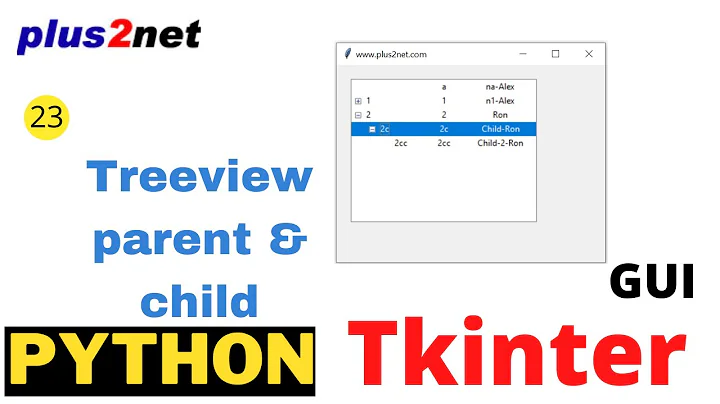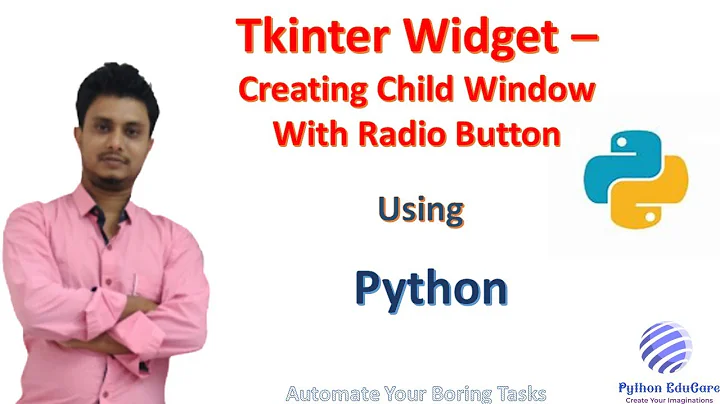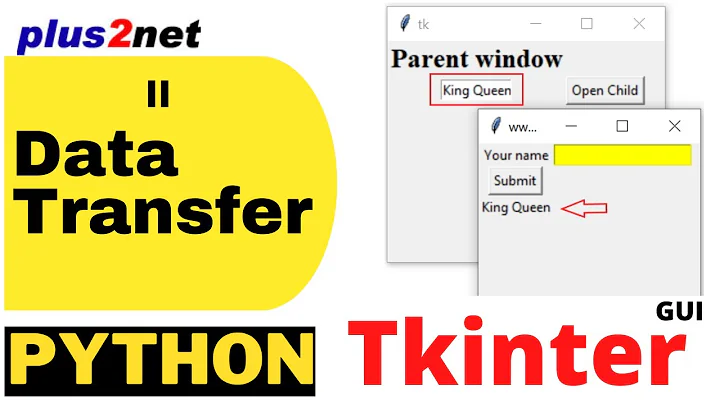How to create child window and communicate with parent in TkInter
Solution 1
There are at least a couple ways to solve your problem. Either your dialog can directly send information to the main application, or your dialog can generate an event that tells the main application that data is really to be pulled from the dialog. If the dialog simply changes the appearance of something (for example, a font dialog) I usually generate an event. If the dialog creates or deletes data I typically have it push information back to the application.
I typically have an application object that acts as the controller for the GUI as a whole. Often this is the same class as the main window, or it can be a separate class or even defined as a mixin. This application object has methods that dialogs can call to feed data to the application.
For example:
class ChildDialog(tk.Toplevel):
def __init__(self, parent, app, ...)
self.app = app
...
self.ok_button = tk.Button(parent, ..., command=self.on_ok)
...
def on_ok(self):
# send the data to the parent
self.app.new_data(... data from this dialog ...)
class MainApplication(tk.Tk):
...
def on_show_dialog(self):
dialog = ChildDialog(self)
dialog.show()
def new_data(self, data):
... process data that was passed in from a dialog ...
When creating the dialog, you pass in a reference to the application object. The dialog then knows to call a specific method on this object to send data back to the application.
If you're not into the whole model/view/controller thing you can just as easily pass in a function rather than an object, effectively telling the dialog "call this function when you want to give me data".
Solution 2
In one of my projects I was trying to check within a child tk.Toplevel window (child1) of my root window (self), if a tk.Toplevel window (child2) was created by the user from within the root window, and if this window (child2) is present at the users screen at the moment.
If this wouldn't be the case, the new tk.Toplevel window should gets created by the child window (child1) of the root window, instead of the root window itself. And if it was already created by the root window and is currently present at the users screen, it should get focus() instead of getting reinitialized by "child1".
The root window was wrapped inside a class called App() and both "children" windows were created by methods inside the root class App().
I had to initialize "child2" in a quiet mode if an argument given to the method was True. I suppose that was the entangled mistake. The problem occurred on Windows 7 64 bit, if that's significant.
I tried this (example):
import tkinter as tk
from tkinter import ttk
class App(tk.Tk):
def __init__(self):
tk.Tk.__init__(self)
top = self.winfo_toplevel()
self.menuBar = tk.Menu(top)
top['menu'] = self.menuBar
self.menuBar.add_command(label='Child1', command=self.__create_child1)
self.menuBar.add_command(label='Child2', command=lambda: self.__create_child2(True))
self.TestLabel = ttk.Label(self, text='Use the buttons from the toplevel menu.')
self.TestLabel.pack()
self.__create_child2(False)
def __create_child1(self):
self.Child1Window = tk.Toplevel(master=self, width=100, height=100)
self.Child1WindowButton = ttk.Button(self.Child1Window, text='Focus Child2 window else create Child2 window', command=self.CheckForChild2)
self.Child1WindowButton.pack()
def __create_child2(self, givenarg):
self.Child2Window = tk.Toplevel(master=self, width=100, height=100)
if givenarg == False:
self.Child2Window.withdraw()
# Init some vars or widgets
self.Child2Window = None
else:
self.Child2Window.TestLabel = ttk.Label(self.Child2Window, text='This is Child 2')
self.Child2Window.TestLabel.pack()
def CheckForChild2(self):
if self.Child2Window:
if self.Child2Window.winfo_exists():
self.Child2Window.focus()
else:
self.__create_child2(True)
else:
self.__create_child2(True)
if __name__ == '__main__':
App().mainloop()
Here comes the problem: I wasn't able to check if "child2" is already present. Got error: _tkinter.TclError: bad window path name
Solution:
The only way to get the right 'window path name' was, instead of calling the winfo_exists() method directly onto the "child2" window, calling the master of the "child1" window and adding the according attributes followed by the attributes of the master window you want to use.
Example (edit of the method CheckForChild2):
def CheckForChild2(self):
if self.Child2Window:
if self.Child1Window.master.Child2Window.winfo_exists():
self.Child1Window.master.Child2Window.focus()
else:
self.__create_child2(True)
else:
self.__create_child2(True)
Related videos on Youtube
Component 10
Updated on September 16, 2022Comments
-
Component 10 over 1 year
I'm creating some dialogs using TkInter and need to be able to open a child sub-window (modal or modeless) on clicking a button in the parent. The child would then allow a data record to be created and this data (either the record or if the operation was cancelled) needs to be communicated back to the parent window. So far I have:
import sel_company_dlg from Tkinter import Tk def main(): root = Tk() myCmp = sel_company_dlg.SelCompanyDlg(root) root.mainloop() if __name__ == '__main__': main()This invokes the top level dialog which allows the user to select a company. The company selection dialog looks like this:
class SelCompanyDlg(Frame): def __init__(self, parent): Frame.__init__(self, parent) self.parent_ = parent self.frame_ = Frame( self.parent_ ) // .. more init stuff .. self.btNew_ = Button( self.frame_, text="New ...", command=self.onNew ) def onNew(self): root = Toplevel() myCmp = company_dlg.CompanyDlg(root)On clicking the New ... button, a Create Company dialog is displayed which allows the user to fill in company details and click on create or cancel. Here's the opening bit of that:
class CompanyDlg(Frame): def __init__(self, parent): Frame.__init__(self, parent) // etc.I'm struggling with the best way of invoking the child dialog in
onNew()- what I have works but I'm not convinced it's the best approach and also, I can't see how to communicate the details to and from the child dialog.I've tried looking at online tutorials / references but what I've found is either too simplistic or focuses on things like
tkMessageBox.showinfo()which iss not what I want. -
Component 10 almost 12 yearsThanks very much for this, it's really helped.
-
 AJN about 9 years#bryan-oakley Nice summary of techniques. Do you recommend any more details references on such techniques (Internet or book resources) on data exchange between parents and child windows? : - event generation back to parent - pushing data back to parent - ...
AJN about 9 years#bryan-oakley Nice summary of techniques. Do you recommend any more details references on such techniques (Internet or book resources) on data exchange between parents and child windows? : - event generation back to parent - pushing data back to parent - ...





